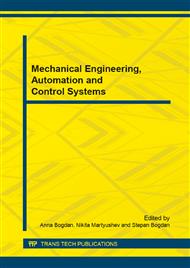p.3
p.8
p.15
p.19
p.24
p.29
p.35
p.41
p.47
Electric Drill Drive with Intermediate Rolling Members Reducer
Abstract:
The article considers briefly the hand power tool market in Russia. The authors set the parameters of a wave gear electric drill with intermediate rolling solids. Its field of application is also described. The design is developed on the basis of a commutator motor with a useful capacity 1,0 kW. The rotation speed of the motor armature is 15000 rpm. The rational rotation frequency of an auger working body is 200...300rpm. It is necessary to create a gear with a ratio 59 and with parameters comparable to the size of a hand-held machine engine in order to have esthetics. In this case, the diameter of rolling elements should lie in the range 2 to 3 mm. The authors made a research on hand-held electric drill runnability with such characteristics. They presented dependency diagrams of an auger working body critical rotation frequency from a lead angle while drilling different types of soil. They determined important power and geometrical criteria to design a gearbox. The calculation results are presented in tables.
Info:
Periodical:
Pages:
24-28
Citation:
Online since:
April 2015
Authors:
Price:
Сopyright:
© 2015 Trans Tech Publications Ltd. All Rights Reserved
Share:
Citation:


